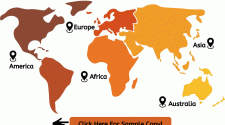“It’s been a total disaster. They have — they’re six weeks into it now, they have no clue what’s going on. And I mean I think I can say right here and now, I think you have to rerun that race because it’s a mess. Nobody knows what’s happening with the ballots and the lost ballots and the fraudulent ballots, I guess,” Trump said. He said a bit later that “there’s fraudulent ballots,” this time omitting the “I guess.”
Absentee vs. Mail-in ballots
Not for the first time, Trump implied absentee ballots were significantly different from mail-in ballots.
“Absentee ballots are great. Absentee ballots, they have to request them, they go through a process, they get them,” Trump said Monday. “But the universal mail-in ballots have turned out to be a disaster.”
“The bottom line is that absentee and mail balloting are secure in America,” Wendy Weiser, the director of the Democracy Program at the Brennan Center, told CNN. “Election officials, Republicans and Democrats alike, pretty much universally are confident in the system.”
Executive order on mail-in voting
When asked if he would consider signing an executive order (in the reporter’s words) “addressing mail-in ballots” Trump said he had the “right to do it.”
Facts First: It’s unclear what sort of order Trump believes he has the right to issue on mail-in ballots but the Constitution does not give the President authority over voting methods. That authority rests in the states.
The US Postal Service
The President also suggested the US Postal Service was unprepared to handle an influx of mail-in ballots that are expected later this year.
“I don’t think the post office is prepared for a thing like this. You’ll have to ask the people at the post office,” Trump said.
Facts First: Trump is directly refuting the comments of his own US Postal Service here, which said in a statement released Monday that it had the capacity to handle the additional volume of election-related mail.
Prescription drug prices
Trump claimed that there was a decline in prescription drug prices “last year.” He claimed this was the first such decline in “51 years.”
Trump started making versions of this claim in 2019, when “last year” was correct. But he is now touting an outdated statistic that makes the 2019 situation sound better than it was.
PPE
In touting his administration’s response to the pandemic, Trump suggested that frontline workers have all the supplies they need. Trump said that hospitals, states and nursing homes “are very much stocked up” when it comes to personal protective equipment. “They’re in great shape,” the President added.
Facts First: Hospitals and health care professionals have continued to report low levels of PPE this summer as cases of the virus surged throughout the US.
“If you sneeze in your mask, you still have to wear it your entire shift,” said Barbara Murray, a nurse at the hospital told the Times. A spokeswoman for St. Petersburg General declined to comment on the hospital’s mask policies but told the New York Times that adequate supplies were available to employees who needed them.
These are just a few examples of the ongoing struggle to secure enough PPE to care for patients. It’s not true that all hospitals and other caregiving facilities are “in great shape” when it comes to their supply of PPE.
The pandemic in the US and other countries
Trump responded, “I think we’re doing very well. And I think that we have done as well as any nation — if you really look, if you take a look at what’s going on, especially now with all these flare-ups” in countries where the virus appeared to have been suppressed.
Facts First: We give Trump wide latitude to express opinions, but it’s simply ridiculous to claim that the US has done as well as “any nation.” Numerous countries have kept their numbers of coronavirus cases and deaths far below the US numbers, whether in absolute terms or per capita. And some countries that have been praised for their response to the virus are indeed having “flare-ups,” but those flare-ups pale in comparison to the ongoing US crisis.
There’s just no comparison.


















